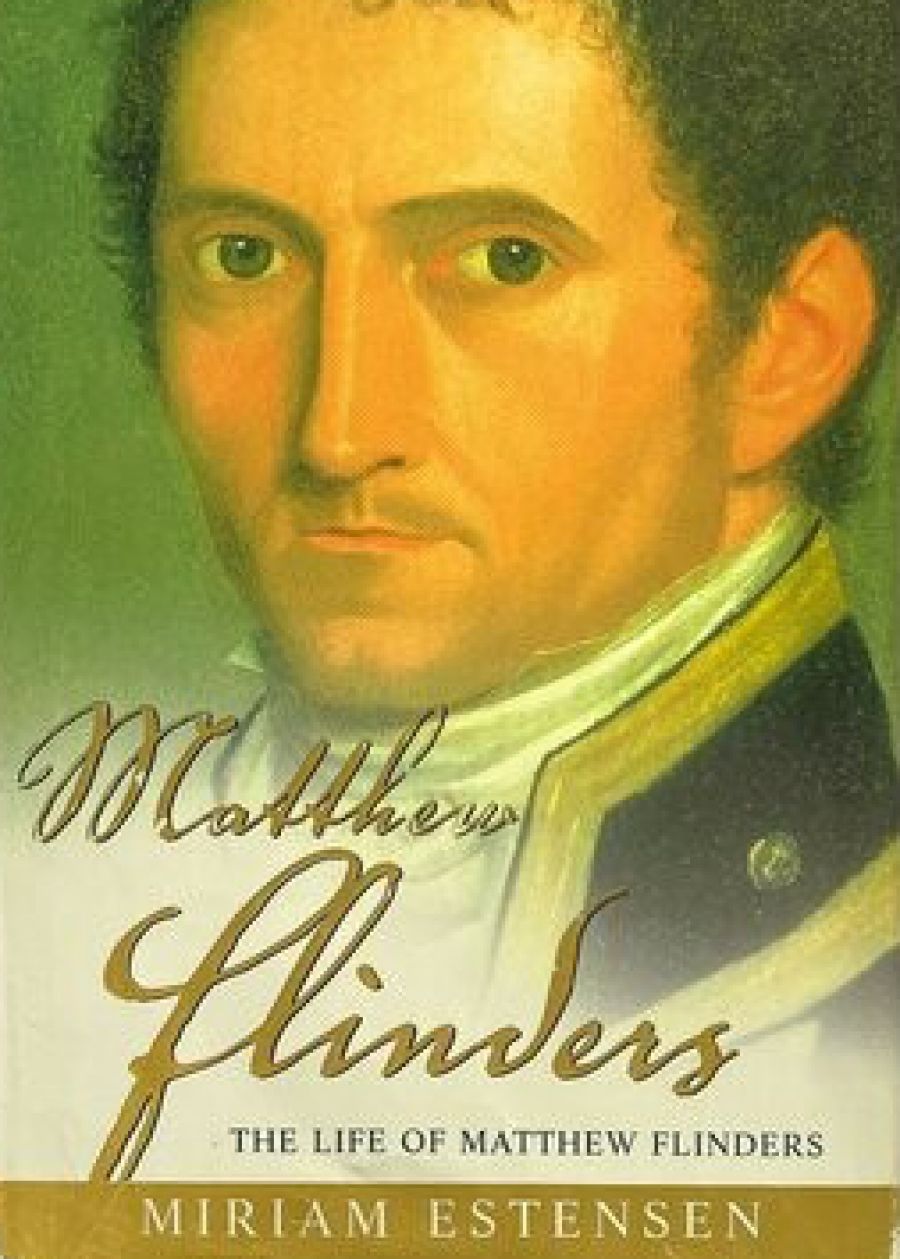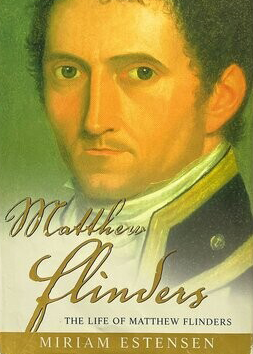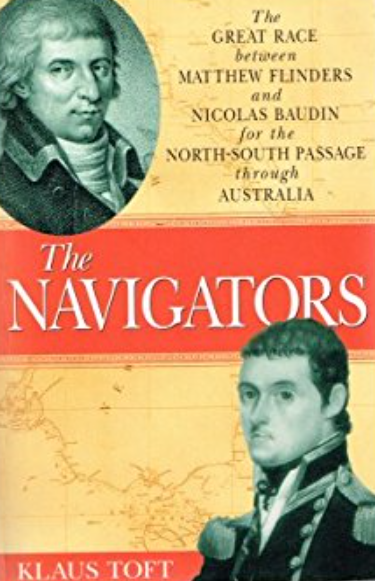
- Free Article: No
- Contents Category: Australian History
- Review Article: Yes
- Article Title: The Tongue of Slander
- Online Only: No
- Custom Highlight Text:
In the fever of bicentennial celebrations of Flinders’ circumnavigation of Australia, thousands of words have been written and dozens of new books have appeared. The South Australian events and publications alone celebrating the encounter between Flinders and Baudin have almost reached plague proportions. However, Miriam Estensen’s Life of Matthew Flinders is the first full-blown biography of Flinders since Geoffrey Ingleton’s Matthew Flinders: Navigator and Chartmaker (1986), a deluxe volume not intended for the mass market. A paperback edition of Ernest Scott’s 1914 biography recently appeared, but new sources have become available since then and it is certainly time for a fresh assessment of Flinders’ achievements and character based on all the available evidence we now have.
- Book 1 Title: The Life of Matthew Flinders
- Book 1 Biblio: Allen & Unwin, $59.95 hb, 554pp
- Book 1 Cover Small (400 x 600):

- Book 1 Cover (800 x 1200):

- Book 2 Title: The Navigators
- Book 2 Subtitle: The Great Race between Matthew Flinders and Nicolas Baudin for the North-South Passage through Australia
- Book 2 Biblio: Duffy & Snellgrove, $19.95 pb, 364pp
- Book 2 Cover Small (400 x 600):

- Book 2 Cover (800 x 1200):

Estensen’s book is a work of painstaking scholarship, worn lightly. I find it hard to fault in any significant way. Her style is easy to read, her judgments shrewd and well-informed, her use of background information adequate but not intrusive. There are no rhetorical tricks: Flinders’ birth is related in the second paragraph of the first chapter, and the narrative proceeds in an orderly fashion to the end of his life. A small amount of family history is provided, but we are not burdened with an extensive genealogy.
A figure like Flinders is particularly susceptible to historical gossip-mongering. He himself remarked:
Let the conduct of a woman on board a ship without her husband, be ever so prudent and circumspect, the tongue of slander will almost certainly find occasion, or it will create one, to embitter the future peace of her husband and family.
The same, it seems, applies to a man without his wife. Recent commentators have pounced gleefully on evidence that Flinders contracted venereal disease during his teenage voyage with Bligh in the early 1790s, and have regarded this as evidence of a later promiscuity that seems to have no basis either in the historical record or in what is known of Flinders’ character and personality. Rumours abound about his relationship with Delphine D’Arifat, the daughter of the family with whom he lived for four years while detained on Mauritius. Certainly, there are intriguing references to Delphine in Flinders’ journal, and a letter he drafted but never sent her showed how disturbingly attractive he found her, but it is difficult to believe that his close friendship with the D’Arifat family, including Delphine’s mother and older brothers, would have survived an affair. It is far more likely that the coolness that sprang up between Delphine and Flinders resulted, as Estensen surmises, from her disappointed hopes, perhaps at first indiscreetly encouraged by Flinders but soon quenched.
It is, I suppose, hard to believe that he remained chaste for nine whole years away from his wife. Estensen, however, wisely wastes little speculation on such matters. ‘He loved his wife,’ she says, ‘with, on the evidence, absolute devotion.’ Their love story is the stuff of legends, and legends have a way of inviting deconstruction in our cynical times. Estensen is quite right to rise above the gossip, but I do wonder whether she idealises Ann a little, perhaps failing to read between the lines. Upon Flinders’ return in 1810, ‘Ann no doubt watched with overflowing pride and happiness’ while Flinders related the stories of his adventures ‘over and over to fascinated listeners’. Yes, perhaps; but the strains of the past nine years, the shock of being confronted with a physically altered husband, and the stress of adjusting to her new life as a married woman, can be readily imagined.
There was a possible source of tension, too, in their different attitudes to religion. Estensen observes that Flinders, although following religious forms, was not especially devout: ‘religion was an area of belief and abstractions that Flinders generally avoided.’ Ann, on the other hand, was deeply religious. Most of her own letters to Flinders were destroyed, but surviving letters written to family members after his death show a woman of strong and somewhat intolerant religious beliefs. The one remaining letter from Ann to Matthew was never delivered: it was written before the birth of her daughter, to be read in the event of her death in childbirth (which she survived by forty years, while he died two years later). It is a deeply moving document testifying to a deep and satisfied love, but it is significant that she earnestly pleads with him to pray. It can be assumed from this that she felt he was disinclined to do so without encouragement, and this might well have been a source of some friction in the marriage.
The fashionable belief is that Flinders died from complications related to his youthful sexual indiscretions. Estensen plausibly explains this away, saying that he died ‘insofar as a modern diagnosis can be made, from renal failure’, and that it is unlikely ‘that his early venereal infections had any direct bearing on it’. Unfortunately, she gives no authority for this medical opinion that would help discredit the gossips.
These are minor quibbles, and do not detract from my hearty recommendation of this biography. Estensen obviously admires Flinders but does not adulate him. She deals fairly with his captor Decaen, seeing fault on both sides, and she assesses his achievements with a cool eye, explaining, for example, his failure to discover any major rivers by a discussion of Australia’s geographical differences from Europe. I am not aware of any important sources she has failed to consult, and her bibliography and references are extensive. There is a good collection of illustrations, some in colour: most available portraits of significant people are included. Above all, this book is a pleasure to read without ever falling below an exalted standard of scholarship. It will be an enduring contribution to Australian history.
Klaus Toft’s The Navigators does not aspire to the same level of scholarship. A tie-in to an ABC mini-series, it is a book written with a mission. Originally engaged to produce a documentary on Flinders, Toft became convinced that Baudin’s story was as vital and interesting as Flinders’, and the material for his programme spilled over into this book. As he acknowledges, much of this ground has been covered already in Anthony Brown’s Ill-Starred Captains, and Toft’s work relies heavily on this and other less reliable secondary sources, as well as journals and letters. Written in a breezy but inoffensive and highly readable style, it manages to convey the difficulties faced by both captains, and the immense injustice Baudin’s reputation suffered, both personally and professionally, after his death. He emerges as an able, intelligent commander beset by jealous and ignorant enemies among his officers and the scientists he was lumbered with on his voyage. The subtitle of this book is quite misleading. Flinders was in a hurry, it is true; but the non-existence of the north–south passage was established at the famous encounter in April 1802, and is therefore irrelevant to nearly two-thirds of the book. For both captains, the race was more against disease and weather than each other. However, it makes a highly entertaining adventure story with a fairly solid basis in fact, and should do much to popularise this episode in Australia’s early history.


Comments powered by CComment